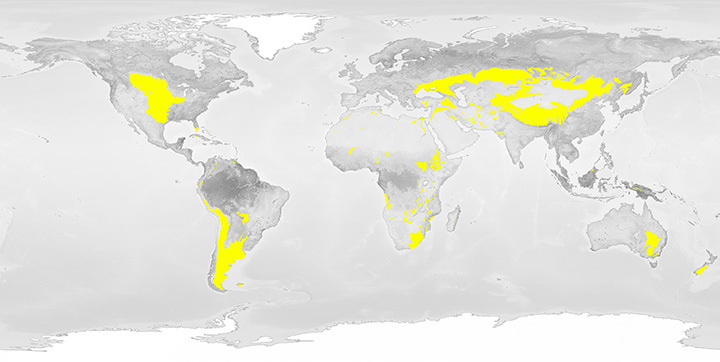



Dependent on latitude, the annual range can be between -20°C (-4°F) to 30°C (86°F).
Grasslands receive around 500 to 900 millimeters (20 – 35 inches) of rain per year.
Grasses (prairie clover, salvia, oats, wheat, barley, coneflowers)

The prairies of the Great Plains of North America, the pampas of South America, the veldt of South Africa, the steppes of Central Eurasia, and surrounding the deserts in Australia
Found on every continent except Antarctica
Monthly Temperature and Precipitation from 1970 - 2000
| Month | Average Monthly Precipitation (mm) | Average Monthly Temperature (°C) |
|---|---|---|
| January | 46 | 10 |
| February | 56 | 12 |
| March | 49 | 16 |
| April | 69 | 20 |
| May | 122 | 24 |
| June | 96 | 27 |
| July | 49 | 29 |
| August | 51 | 29 |
| September | 88 | 26 |
| October | 87 | 21 |
| November | 65 | 15 |
| December | 50 | 11 |
| Sum Annual Precip. | 828 |
Grasslands are generally open and continuous, fairly flat areas of grass. They are often located between temperate forests at high latitudes and deserts at subtropical latitudes. Grasses vary in size from 2.1 m (7 ft) tall with roots extending down into the soil 1.8 m (6 ft), to the short grasses growing to a height of only 20 to 25 cm (8 to 10 in) tall. These short grasses can have roots that extend 1 m (about 3 ft) deep.
The height of grass correlates with the amount of rainfall it receives. Grasslands receive about 500 to 950 mm of rain per year compared to deserts, which receive less than 300 mm and tropical forests, which receive more than 2,000 mm. While temperatures are often extreme in some grasslands, the average temperatures are about -20°C to 30°C. Tropical grasslands have dry and wet seasons that remain warm all the time. Temperate grasslands have cold winters and warm summers with some rain.
The grasses die back to their roots annually and the soil and the sod protect the roots and the new buds from the cold of winter or dry conditions. A few trees may be found in this biome along the streams, but not many due to the lack of rainfall.